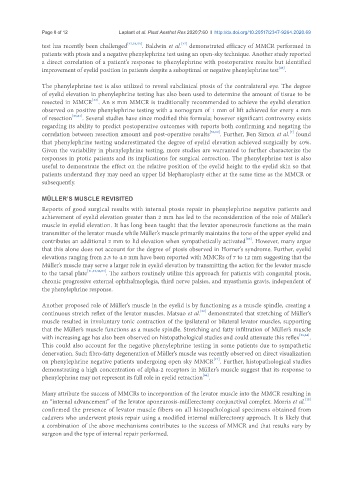Page 708 - Read Online
P. 708
Page 8 of 12 Laplant et al. Plast Aesthet Res 2020;7:60 I http://dx.doi.org/10.20517/2347-9264.2020.69
[47]
test has recently been challenged [47,51,53] . Baldwin et al. demonstrated efficacy of MMCR performed in
patients with ptosis and a negative phenylephrine test using an open-sky technique. Another study reported
a direct correlation of a patient’s response to phenylephrine with postoperative results but identified
[46]
improvement of eyelid position in patients despite a suboptimal or negative phenylephrine test .
The phenylephrine test is also utilized to reveal subclinical ptosis of the contralateral eye. The degree
of eyelid elevation in phenylephrine testing has also been used to determine the amount of tissue to be
[33]
resected in MMCR . An 8 mm MMCR is traditionally recommended to achieve the eyelid elevation
observed on positive phenylephrine testing with a nomogram of 1 mm of lift achieved for every 4 mm
of resection [33,61] . Several studies have since modified this formula; however significant controversy exists
regarding its ability to predict postoperative outcomes with reports both confirming and negating the
[7]
correlation between resection amount and post-operative results [36,62] . Further, Ben Simon et al. found
that phenylephrine testing underestimated the degree of eyelid elevation achieved surgically by 40%.
Given the variability in phenylephrine testing, more studies are warranted to further characterize the
responses in ptotic patients and its implications for surgical correction. The phenylephrine test is also
useful to demonstrate the effect on the relative position of the eyelid height to the eyelid skin so that
patients understand they may need an upper lid blepharoplasty either at the same time as the MMCR or
subsequently.
MÜLLER’S MUSCLE REVISITED
Reports of good surgical results with internal ptosis repair in phenylephrine negative patients and
achievement of eyelid elevation greater than 2 mm has led to the reconsideration of the role of Müller’s
muscle in eyelid elevation. It has long been taught that the levator aponeurosis functions as the main
transmitter of the levator muscle while Müller’s muscle primarily maintains the tone of the upper eyelid and
contributes an additional 2 mm to lid elevation when sympathetically activated . However, many argue
[63]
that this alone does not account for the degree of ptosis observed in Horner’s syndrome. Further, eyelid
elevations ranging from 2.5 to 4.0 mm have been reported with MMCRs of 7 to 12 mm suggesting that the
Müller’s muscle may serve a larger role in eyelid elevation by transmitting the action for the levator muscle
to the tarsal plate [11,12,36,64] . The authors routinely utilize this approach for patients with congenital ptosis,
chronic progressive external ophthalmoplegia, third nerve palsies, and myasthenia gravis, independent of
the phenylephrine response.
Another proposed role of Müller’s muscle in the eyelid is by functioning as a muscle spindle, creating a
[52]
continuous stretch reflex of the levator muscles. Matsuo et al. demonstrated that stretching of Müller’s
muscle resulted in involuntary tonic contraction of the ipsilateral or bilateral levator muscles, supporting
that the Müller’s muscle functions as a muscle spindle. Stretching and fatty infiltration of Müller’s muscle
with increasing age has also been observed on histopathological studies and could attenuate this reflex [29,65] .
This could also account for the negative phenylephrine testing in some patients due to sympathetic
denervation. Such fibro-fatty degeneration of Müller’s muscle was recently observed on direct visualization
[47]
on phenylephrine negative patients undergoing open sky MMCR . Further, histopathological studies
demonstrating a high concentration of alpha-2 receptors in Müller’s muscle suggest that its response to
[66]
phenylephrine may not represent its full role in eyelid retraction .
Many attribute the success of MMCRs to incorporation of the levator muscle into the MMCR resulting in
an “internal advancement” of the levator aponeurosis-müllerectomy conjunctival complex. Morris et al.
[12]
confirmed the presence of levator muscle fibers on all histopathological specimens obtained from
cadavers who underwent ptosis repair using a modified internal müllerectomy approach. It is likely that
a combination of the above mechanisms contributes to the success of MMCR and that results vary by
surgeon and the type of internal repair performed.

